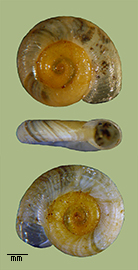> Habitat & Distribution
Gyraulus circumstriatus is an element of the northern or western montaine malacofauna, restricted to lentic environments above the Pleistocene glacial maximum. We have seen published records from Connecticut (Jokinen 1983), New York (Jokinen 1992), northern Michigan (Burch & Jung 1992), and Wisconsin (Jass 2004). The single G. circumstriatus population of which we are aware in the Ohio River basin inhabits a vernal pond in extreme NW Pennsylvania. The species is pseudo-rare in our 17-state eastern study region, FWGNA incidence rank I-1p.
We have two records in our Great Plains database, both from North Dakota. Clarke (1981) reported populations across the breadth of Canada, from Nova Scotia through the Great Lakes/St. Lawrence system to British Columbia. He observed, "characteristic of small, vernal habitats such as woodland pools, marshes, roadside ditches, prairie ponds, and intermittent streams. Vegetation is ordinarily thick, and substrates are commonly mud."
> Ecology & Life History
Populations of G. circumstriatus are not as common or widespread as their congeners G. parvus and G. deflectus, and much less is known about them. Jokinen (1985) reported that the Gyraulus circumstriatus population inhabiting Roseland Lake, a small, shallow natural lake in northeastern Connecticut, displayed continual recruitment. She was unable to detect any cohort structure in the population, apparently reproducing all spring, summer, and autumn, overwintering as a mixture of size classes.
> Taxonomy & Systematics
Originally described in the genus Planorbis, Tryon's (1866) nomen circumstriatus has remained taxonomically stable since its transfer to Gyraulus in the early 20th century. Dall (1905) considered circumstriatus, parvus, and several more obscure taxa sufficiently distinct from other Gyraulus that he proposed a "section" Torquis to contain it, which Baker (1945) considered a subgenus.
Lorencova and colleagues (2021) included a small sample of North American Gyraulus circumstriatus in their large scale genetic survey of G. parvus and G. laevis, suggesting (in passing) that all three might be conspecific. See my essay of 4Feb22 from the link below for evidence to the contrary.
The classification of the Planorbidae proposed by the tag team of Baker (1945) and Hubendick (1955) remains, after 50 years, the basis for our understanding of this large and diverse family of pulmonates worldwide. See my essay of 11Apr08 from the link below for more.
> Maps and Supplementary Resources
- Gyraulus distribution in drainages of The Ohio (2019)
- Gyraulus distribution in The Great Plains (2024)
> Essays
- See my post to the FWGNA blog of 11Apr08 for a review of the Classification of the Planorbidae.
- Or view the (Hubendick 1955) classification of North American planorbids in a tabular format [here].
- Lorencova et al. (2021) suggested that North American populations of G. circumstriatus might be conspecific with G. parvus and European G. laevis. I critiqued this hypothesis in my essay of 4Feb22, Character phase disequilibrium in the Gyraulus of Europe.
> References
Baker, F. (1945) The
Molluscan Family Planorbidae. Urbana: University of Illinois
Press.
Baker, H. B. (1946)
Index to F.C. Baker's "The Molluscan Family Planorbidae." Nautilus, 59,
127-41.
Burch, J. B. & Y.
Jung (1992) Freshwater snails of the University
of Michigan Biological Station area. Walkerana 6(15): 1 - 218.
Dillon, R. T., Jr. (2000) The Ecology of Freshwater
Molluscs. Cambridge University Press, Cambridge, England. 509 pp.
Horst, T. & R.
Costa ( 1971) Distribution patterns of five selected
gastropod species from McCargo Lake. Nautilus, 85: 38-43.
Hubendick, B.
(1955) Phylogeny in the Planorbidae.
Trans. Zool. Soc. London 28: 453-542.
Jass, J. P.
(2004) Distributions of gastropods in Wisconsin.
Milwaukee Public Museum Contributions 99: 1 - 28.
Jokinen, E. (1983)
The freshwater snails of Connecticut.
State Geological and Natural History Survey of Connecticut
Bulletin 109: 1 - 83.
Jokinen, E. (1985) Comparative
life history patterns within a littoral zone snail community.
Verh. Internat. Verein. Limnol 22: 3292 - 3299.
Jokinen, E. (1992)
The freshwater snails (Mollusca: Gastropoda) of New York
State. New York State Museum Bulletin 482: 1 - 112.
Lorencova, E., L. Beran,
M. Novakova, V. Horsakova, B. Rowson, J. Hlavac, J. Nekola, and M.
Horsak (2021). Invasion at the population level:
a story of the freshwater snails Gyraulus
parvus and G.
laevis. Hydrobiologia 848: 4661 4671.
Martin, T., L. Crowder,
C. Dumas, & J. Burkholder (1992)
Indirect effects of fish predation on macrophytes in Bays Mountain
Lake: Evidence for a littoral trophic cascade. Oecologia, 89:
476-81.
McKillop, W. (1985)
Distribution of aquatic gastropods across the Ordovician dolomite
Precambrian granite contact in southeastern Manitoba. Can. J.
Zool., 63: 278-88.
Osenberg, C. (1989)
Resource
limitation, competition and the influence of life history in a
freshwater snail community. Oecologia, 79: 512-19.
Sheldon, S, P. (1987)
The effects of herbivorous snails on submerged communities in Minnesota
lakes. Ecology, 68: 1920-31.
Thorpe, J. & E.
Bergey (1981)
Field experiments on responses of a freshwater benthic
macroinvertebrate community to vertebrate predators. Ecology, 62:
365-75.








